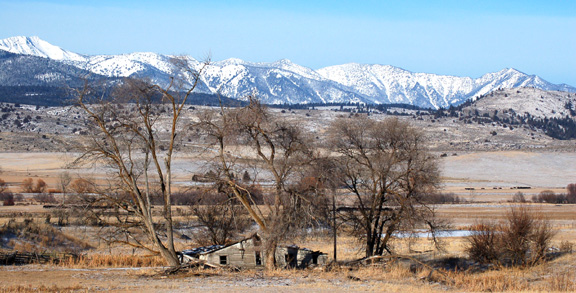Wolves

Gray Wolf (Canis lupis) [USF&WS Photo]
I enjoyed the Herald Tuesday’s article by Jayson Jacoby on the dispersal of wolves into North East Oregon. It was gratifying to see it as it helps confirm my sighting of a pair of wolves near Lick Creek (Wallowa County) in August of this year. I reported the sighting to the Fish & Wildlife Service that month, but apparently they were unable to independently confirm it. Good that the snow held the tracks found by a local rancher, hopefully not one of the “shoot, shovel, and shut-up” up crowd, so that wolves could be confirmed this year. We should be relieved that the wolf has finally come home. I look forward to hearing their howls in the coming years but predator persecution has a long history in America, and in Eastern Oregon in particular (2 of 4 recent wolf migrants have been shot). Hopefully the State and Federal government will take their responsibilities seriously and protect the wolves from those who have vowed to stop their reintroduction here.
In America, the practice of predator persecution by the agricultural “producer” community has its roots in the insecurity of an expanding agrarian pioneer population dating back to the arrival of Europeans on this continent during the 1600’s. It has since spread to the hunting industrial complex, which has concerns that it will reduce numbers of “game” species, like elk and deer, which in turn could reduce the number of tags allowed and licenses sold. This could lower income to the State hunting bureaucracy, to gun shops and ammunition dealers, and ultimately to local communities who depend on the flush of hunter dollars in the fall. (On the other hand, it might bring the curious into the area hoping to view or hear wolves.)
Bounties on wolves were offered as early as 1630 in the Massachusetts Colony, at which time, some 250,00 or more wolves roamed America’s wild lands. By about 1700, wolves had been eliminated from the Eastern United States. According to the Wild Rockies Alliance, “Professional ‘wolfers’ working for the livestock industry laid out strychnine-poisoned meat lines up to 150 miles long. Wolves were shot, poisoned, trapped, clubbed, set on fire and inoculated with mange, a painful and often fatal skin disease caused by mites.” The persecution reached its apex in the late 1800’s and into the early years of the last century, by which time it is estimated that some 55,000 wolves a year were being executed. Between 1918 and 1920, over 128,500 wolves were slaughtered in the Western U. S.
A palpable hatred for both predators and other “varmints” is revealed in articles printed in the U.S. Department of Agriculture Year Book for 1920, where classics like “Hunting Down Stock Killers” and “Death To The Rodents” can be found.

Some quotes:
“Uncle Sam, tired of a drain on his resources of from $20,000,000 to $30,000,000 every year through the slaughter [slaughter is to be reserved for humans alone] of domestic stock by predatory animals, now keeps constantly in the field a force of hunters who are instructed to wipe out these nonproducers. In their place, and safe from their depredations, it is the aim to populate the range country [I.e., primarily public lands] with flocks and herds….”
. . . .
“Losses of live stock from ravages of predatory animals are among the most spectacular and exasperating of those suffered by the stockman. Disease may decimate his flocks and herds, or drought or wintry storms may result in the starvation or death of numbers of valuable animals. None of these disasters, however, arouses such resentment and determination to settle the score as arises in the heart of the ranchman when wolves or other stock destroyers enter corrals or operate on the open range [public lands], maiming and killing his cattle or other domestic stock.”
. . . .
“Men with keen insight into animal psychology and the ways and motives of wild creatures had sought out improved methods of luring them to destruction when their presence was detrimental to the live-stock business.”
. . . .
“Careful field studies of the abundance, habits, and relationship of predatory animals to the live-stock industry had been made by the Biological Survey of the United States Department of Agriculture for many years.”
. . . .
“. . . the death of the Custer wolf was hailed with delight by stockmen throughout the region where the depredations had occurred, and has added to the impetus to a movement for cooperation with the Department in order to meet more adequately the needs of the live-stock industry.”

“Evidence that Uncle Sam’s Hunters Get results”
In another part of the article titled “’Getting’ the Chief Offenders,” a caption, under a photo of trapped coyotes and wolves, and of a “hunter” spreading poisoned baits, states: “Trapped coyote—more than 250,000 of his ilk have been accounted for [killed] in five years by Federal and cooperating hunters.” [Emphasis added]
It is clear from these attitudes that the American people are expected to sacrifice their public ecosystems, and all the species there-in, (not to mention their tax dollars flowing to the U.S.D.A predator control efforts, Forest Service, and Bureau of Land Management) to the economic interests of ranchers. In practice, that is exactly what has occurred. Like every thing else in our corrupt American “democracy,” the theft of our public lands and ecosystems has been financed by the economic power of special interest groups like the various Cattlemen’s Associations. This is accomplished through their financial contributions to members of Congress, especially in districts where extractive industries and ranchers have large landholdings with the significant economic and social power that those holdings bring.

And it is not just native predators who suffer. Prairie dogs and other important rodents have suffered as well. As the picture above illustrates, prairie dogs, and those who depend on them, like the black-footed ferret, have been the targets of the stockman’s jihad. Hawks and many other species depend upon the availability of a prey base, which consists largely of rodents, for their survival.

Black-Footed Ferret [USF&WS Photo]

Black-Tailed Prairie Dog [USF&WS Photo]

Swainson’s Hawk [Photo © Christopher Christie]
My question, and that of many in the environmental community, is why should ranchers or hunters have control over which of our native predators should be allowed to have access to their historic habitat on our public lands? The wolf has an important role in maintaining the health of our public ecosystems. If public lands ranchers insist on putting their livestock in a situation where they will naturally become prey, then that is their problem. Our lands should not be managed for the benefit of ranchers and hunters, our lands should be managed for the benefit of native ecosystems and the services they provide for all of the American people.
[For old letter on predator control see:
http://www.rangebiome.org/editorials/oregonwolves.html ]
Prison Labor and U.S. Timber Company
The Record Courier and Brian Addison first broke the story of U.S. Timber’s attempt to get prisoner workers from the Powder River Correctional facility on November 22. The Herald followed up with another article yesterday, December 5th. The later story stated that the Baker County Economic Development Council has endorsed a plan for U.S. Timber to hire the workers at very near the minimum wage for a 6 month period, after which the relationship would be re-evaluated.
According to Jennifer Watkins at City Hall, the development council consists of chairman Craig Ward (a local farmer from the where’s my subsidy crowd), vice-chair Mike Rudi (from the its all about business people Chamber of Commerce crowd), Steve Brocato (with dual membership in both the where’s my subsidy crowd and the I’m in charge of my overall plan crowd) Fred Warner (from the County Commission and the go along to get along crowd), and Terry Schumacher (with dual membership in the its all about business people Chamber of Commerce crowd and the do as I say, not as I do crowd).
So our Economic Development Council has endorsed a plan for U.S. Timber to hire workers at near the minimum wage.
You may remember a time, a decade or so ago, when the use of prison labor in private industry was frowned upon in America—when we bitterly complained about China’s practice of using prison labor to make products exported to the US. It none-the-less has a long American history, going back at least to the early 1800’s when private industry would get their greedy hands on prisoners and literally work them to death. Even though it may look bad to the semi-civilized, it does kind of fit in with the sort of parochial, pre-modern, company-town, muddling towards medieval feel of North East Oregon, and the practice should be a sound addition as the eighth cornerstone of the development council’s economic development plan for Baker County. And what better way to market Baker City than to be known as the town that provides prison labor to private industry? Even if there aren’t enough prisoners to go around, the practice should help keep prevailing wages and benefits at rock bottom, which may have the effect of attracting some really sharp (as in cut-throat), no-nonsense, and otherwise intriguing business people to our little part of paradise.
And what better firm to start the practice than U.S. Timber? What with illegals getting harder and harder to find, and more dangerous to keep, a captive pool of local laborers coerced into pulling the green chain is just what the doctor ordered. With the US leading the world in an ever-expanding number of the incarcerated, prisoners might just outnumber the undocumented in a decade or so. Plus, there are some real economic advantages to using captive labor, including no vacation or sick pay, and even more attractive, no health or unemployment insurance to worry about. It is a brilliant and strategic business decision that should position U.S. Timber to be in the forefront of the prison labor boom-times ahead.
The aspect slow-growth advocates might like is that it should retard economic growth because these workers already have housing at the correctional facility, they don’t drive cars to go shopping, and traffic won’t be an issue. Growth might also be slowed significantly when the word gets out that we are becoming a prison labor center—it just might keep the namby-pamby, progressive riff-raff out, who knows.
Now I know there are those of you who object to the whole sordid prison labor thing, but look at the alternative. As hinted at by Commissioner Warner, if U.S Timber wants to attract a steady, loyal work force, they’d have to offer a living wage and benefits package that would motivate workers to pull the green chain, and what kind of American employer would want to do that?
NPR Democratic Candidates' Debate (12/04/07)
You’d think a question as important as the following might cause NPR, the darlings of the so-called “progressives” in our country, to give all candidates a chance to answer it. But no, they don’t, because NPR is not about progressive politics, it is about giving its listeners the feel-good impression of thoughtless, and most importantly, no cost, progressive politics. They are simply another elitist propaganda machine in the service of the upper and middle classes, which ultimately serves the social status quo. Same for PBS.
From the transcript:
<< SIEGEL: Well, this question comes from a listener. It's political science professor Chris Pence) of Marion, Indiana.
PROF. CHRIS PENCE (MARION, INDIANA): (From tape.) American diplomatic history books recount the Monroe Doctrine, the Truman Doctrine, and will likely discuss the Bush Doctrine. When future historians write of your administration's foreign policy pursuits, what will be noted as your doctrine and the vision you cast for U.S. diplomatic relations?
SIEGEL: Time for a couple of you at least. Senator Clinton, what do you think the Clinton Doctrine will be?
SEN. CLINTON: Blah, blah, blah….
SIEGEL: Thank you, Senator Clinton.
The Edwards Doctrine.
MR. EDWARDS: Blah, blah, blah….
SIEGEL: And Senator Biden, the Biden Doctrine.
SEN. BIDEN: Blah, blah, blah….
SIEGEL: Senator Obama, the short version of the Obama Doctrine.
SEN. OBAMA: Blah, blah, blah….
SIEGEL: And we will continue our debate from Des Moines in just a minute. This is special coverage from NPR News.
(Announcements)
MICHELE NORRIS: From NPR News and Iowa Public Radio, we're back with our debate among the Democratic presidential candidates.
I'm Michele Norris.
SIEGEL: I'm Robert Siegel.
INSKEEP: And I'm Steve Inskeep.
We're broadcasting from Des Moines, Iowa, and in this part of the debate, we're going to focus on a changing China and its effects here at home. >>
Good to hear, once again, who the all important moderators are. But tell me, what was the Kucinich, Gravel, Dodd & etc. doctrine?
We’ll never know if NPR has anything to do with it. But I’ll tell you. . .
In Kucinich’s case it is the Peace Doctrine.
My tally of the debate’s substantive exchanges, offered to my sampling of 3 candidates by the NPR moderators shows the following:
Clinton 15 or 16 exchanges
Kucinich 10 exchanges
Gravel 6 exchanges
God knows what Gravel really thinks, but NPR might not want you to know.
The debate was just one example of NPR’s penchant for shutting down real progressives and independents. More importantly is NPR’s bias with regard to the Israeli occupation of Palestine. There was no question explicitly addressing the most important problem affecting our foreign policy, which is the unqualified support by American leadership of the illegal occupation of Palestinian lands by the colonial and religious state of Israel--the problem that stirs up these "rag-head terrorists."
Former Senator Mike Gravel attempted to address the issue when responding to questions about the threat of Iran and the wisdom of designating the Iranian Revolutionary Guard a “terrorist” organization:
<< MR. GRAVEL: There is no evidence. There is no evidence, and they've produced none. Our military has no evidence and they've not produced any.
But let's — I want to touch something that they're all [the other candidates] giving license to, that there's something wrong with Iran supporting Hamas and Hezbollah. These are two elected organizations, and — and why can't they give support to those organizations? Israel doesn't want it, so why do they buy hook, line and sinker that they can't give aid to Hamas and Hezbollah? We give unlimited aid to Israel. These people are fighting for their rights.
SIEGEL: You believe —
MR. GRAVEL: Is there something wrong with that?
SIEGEL: We'll come back to your points in a moment. >>
But Siegel never came back to give Gravel a chance to elaborate, because that’s his job—to make sure that NPR listeners don’t get the ideas and information they need to accurately understand our destructive Middle East foreign policy and the apartheid Jewish state of Israel. Siegel and NPR feel a need to protect Israel, even if it means victimizing millions of Palestinians, other Arabs and Persians, with spin that characterizes them not as the freedom fighters they are, but as blood-thirsty, crazed demons and “terrorists.” The Muslim resistance to illegal occupations and war crimes by Israel and the US must not be understood to be the legitimate defensive activity that it is, it must be seen as unreasonable criminal activity warranting imperial wars of destruction and/or occupation. The same of course for Iran’s peaceful pursuit of nuclear energy. That’s why little attention is given to the fact that Iran has a legal right under the Article IV of Nuclear Non-proliferation Treaty to develop nuclear energy for peaceful purposes, while the rogue nation of Israel didn’t even sign the treaty and is widely acknowledged to have more than 200 nukes. Our hypocrisy deepens when you examine our treatment of India. India also has nuclear weapons and is not a signatory to the treaty. Yet, in violation of Article III of the treaty, Congress approved the sale of civilian nuclear technology to India. See also: http://www.informationclearinghouse.info/article18837.htm
For more on NPR’s outrageous bias on Palestine see:
http://electronicintifada.net/v2/article3963.shtml
For more on NPR’s not so progressive bias, see:
http://www.fair.org/index.php?page=13
Fairness and Accuracy In Reporting notes that:
<< little evidence has ever been presented for a left bias at NPR, and FAIR’s latest study gives it no support. Looking at partisan sources—including government officials, party officials, campaign workers and consultants—Republicans outnumbered Democrats by more than 3 to 2 (61 percent to 38 percent). A majority of Republican sources when the GOP controls the White House and Congress may not be surprising, but Republicans held a similar though slightly smaller edge (57 percent to 42 percent) in 1993, when Clinton was president and Democrats controlled both houses of Congress. And a lively race for the Democratic presidential nomination was beginning to heat up at the time of the 2003 study.
Partisans from outside the two major parties were almost nowhere to be seen, with the exception of four Libertarian Party representatives who appeared in a single story (Morning Edition , 6/26/03).
Republicans not only had a substantial partisan edge, individual Republicans were NPR ’s most popular sources overall, taking the top seven spots in frequency of appearance. George Bush led all sources for the month with 36 appearances, followed by Defense Secretary Donald Rumsfeld (8) and Sen. Pat Roberts (6). Senate Majority Leader Bill Frist, Secretary of State Colin Powell, White House press secretary Ari Fleischer and Iraq proconsul Paul Bremer all tied with five appearances each.
Senators Edward Kennedy, Jay Rockefeller and Max Baucus were the most frequently heard Democrats, each appearing four times. No nongovernmental source appeared more than three times. With the exception of Secretary of State Powell, all of the top 10 most frequently appearing sources were white male government officials. >>
NPR is still offering up “experts” like Richard Perle, Kenneth Pollack, et. al., and other discredited spokesmen who were cheerleaders for the war in Iraq. They also regularly produce pro-Israel reporters like Linda Gradstein and partisan Zionists like Martin Indyk and Dennis Ross in their ongoing efforts to confuse listeners about Palestine. Even FAIR itself, rarely offers a balanced perspective on the situation in Palestine.
For more on NPR’s coverage of the Palestinian situation, see:
http://electronicintifada.net/v2/article3963.shtml
Little has changed since the article was produced—if anything, reporting about Palestine and Iran on NPR has only become worse.
A study on PBS news content came to similar conclusions.
See
http://www.fair.org/index.php?page=2973 or simply search the archives for several articles.
For more on the corruption of US Middle East foreign policy see:
Mearsheimer and Walt’s original article on the Israel Lobby at the London Review of Books:
http://www.lrb.co.uk/v28/n06/mear01_.html
or, buy their new book--
The Israel Lobby and U.S. Foreign Policy
By Mearsheimer and Walt, $17.16 at Amazon.com
http://www.amazon.com/Israel-Lobby-U-S-Foreign-Policy/dp/0374177724/ref=pd_bbs_sr_1?ie=UTF8&s=books&qid=1196886304&sr=1-1
__
Billy Bragg and Wilco-- "The Unwelcome Guest"
By Woodie Guthrie






































